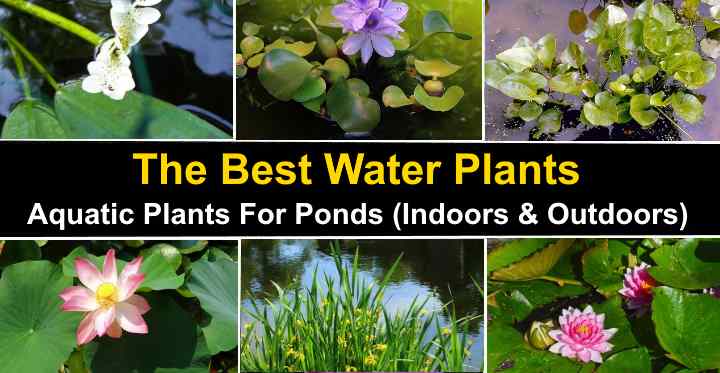Water plants are ideal for ponds at your home, indoor ponds, and aquaria because they can create beautiful natural characteristics. The sorts of plants that thrive only in water, not on land, are known as aquatic plants, or hydrophytes. Water plants supply oxygen, shaded areas, and algae-preventing benefits in ponds or fish tanks.
Some aquatic plants have floating leaves on the water surface, whereas other aquatic plants emerge from the water. Submerged water plants develop entirely underwater, whereas free floating pond plants have no rooted in the bottom earth. Semi aquatic plants are those that grow in watery environments naturally, such as umbrella palm, cattail, and horsetail.
Examples of water plants include: African water fern plant, Anubias, and water purslane plants Duckweed and the mosaic flower are two of the most effective floating water plants on ponds.
Some of the best aquatic flowers is Water lilies, lotus, water Hawthorn plants, and mosaic flowers are all present. Water iris is a showy blue or yellow water-iris that grows in small rivers and streams. You’ll discover the finest aquatic plants to cultivate in home or garden ponds, including those with indoor and outdoor ponds. You may find suitable water aquatic flowers to beautify a pond, create a natural habitat for fish, or establish an indoor pond.
What Are Water Plants?
Water plants are aquatic plants that are completely or partially submerged in water. Depending on how and where they grow in aquatic conditions, plants that survive in water are classified. Emergent plants, underwater plants, free-floating plants, and floating-leaved plants are the four types of water plants.
The Four Types Of Water Plants
The four kinds of water plants are:
- Emergent water plants. These water plants, sometimes known as marginal plants, have roots in the silt of shallow water, often near to the pond’s edge. Above water level, the plant’s foliage predominates.
- Submerged aquatic plants. Oxygenating pond plants are another name for these sorts of water plants. These freshwater and saltwater aquatic plants have stems and leaves that grow completely underwater.
- Free-floating pond plants. A few floating aquatic plants may be seen in the water. They absorb minerals from pond or lake water and have roots that do not grow in sediment or soil.
- Floating-leaved water plants. Deep-water plants are the most gorgeous and stunning types of water plants. The roots of these plants, such as water lilies and lotus, are planted at the pond’s bottom. The tall stems rise to the pond’s surface, where their foliage and blossom appear to float.
Growing Indoor Water Plants
Indoor water gardens or aquarium plants may both be grown with water plants. Floating on indoor ponds, water terrariums, and fish tanks are a variety of plants that thrive in water. The quantity of sunlight required by indoor aquatic plants and outdoor aquatic plants is the only distinction.
Make sure that the water plants you choose can tolerate shade when placed indoors. The tanks are typically covered with aquarium plants, which require artificial light to grow. Plants for fish tanks must tolerate the underwater environment while growing underwater. Water plants, on the other hand, thrive in water terrariums on sunny windowsills.
A jarrarium, a kind of indoor aquaponics system, is another option. A self-sustaining water ecosystem is called a jarrarium. Indoor aquatic plants grow submerged in water in the large glass jar or tank. A jarrarium is a jar full of water and plants that does not contain any fish.
It’s critical to differentiate between aquatic plants and houseplants when discussing plants that bloom in water. Indoor plants are usually kept in pots with potting soil. However, some may also manage to live in water for several weeks or even months. Hydroponics, which is a plant-growing method that doesn’t use soil, is also available. This article, however, is dedicated to aquatic plants (plants that solely grow in water).
Water Plants That Grow in Ponds Indoors (With Picture and Name)
Water plants that may be cultivated in tiny ponds, tanks, aquariums, or jarrariums will be examined in more depth below. All of the plants mentioned below thrive in ponds and wetlands in their natural environments and, of course, outdoors.
African Water Fern Plant (Bolbitis heudelotii)

The African water fern prefers to grow in the shade. For oxygenating water, this aquatic plant is a popular choice. The pinnate leaves of this perennial aquatic plant, also known as Bolbitis water fern, may grow up to 15 inches (40 cm) in length. Aquariums and jarrarium benefit from this shade-loving leafy plant.
Freshwater aquariums are superior to indoor pools for African water fern plants. Their underwater roots will cling to submerged pieces of wood, and oxygen supplementation helps boost growth.
Anubias – Flowering Water Plant

Anubias barteri ‘nana’ is a popular miniature indoor aquatic plant that may be propagated and maintained easily. These aquatic or partly submerged plants flourish in freshwater. Anubias aquatic plants are frequently used to embellish the bottom of aquariums because of their broad, green leaves.
Anubias blooms white in ideal situations. Low to moderate lighting is ideal for Anubias plants. Decorating jarrariums with the slow-growing water plant is also a good idea. Nonetheless, for these plants to grow in water indoors, you may need to add nutrients.
Duckweed Floating Indoor Pond Plant (Lemnaceae)

Duckweed is an oxygenating water plant that floats on the surface and has little leaves. Duckweed is a floating water plant that resembles lentils and grows in ponds. Floating duckweed leaves range in size from 0.5 mm to 6 mm depending on the species.
Duckweed, which forms a natural barrier for fish, is a common aquarium plant and pond plant. Keeping tanks algae-free will be aided by growing these indoor water plants. This aquatic plant may invade wetlands and flourish in full sun or low light, just as well as it may in marshes.
Eelgrass (Vallisneria) – Freshwater Aquatic Plant

Eelgrass is a flourishwater plant that thrives in bright to moderate light and can be found throughout the United States. These submerged plants have long thin blades ranging between 6″ and 23″ (15 – 60 cm) and are also known as the tape plant due to their long green ribbon-like leaves.
Eelgrass blooms are small white flowers that float on the water’s surface and emerge from lengthy stems. Water plants are excellent for big indoor aquariums, providing a natural green backdrop and allowing big and tiny fish to hide.
Amazon Sword Plant for Indoor Ponds (Echinodorus)

Many species of Echinodorus water plants exist. E. is shown in the photograph. E. uruguayensis (left) Amazon sword aquatic plants are oxygenating leafy water plants that may be used to oxygenate indoor ponds and fish tanks. The broad, bright green lanceolate leaves of these aquatic plants They’ve become established in ponds and aquariums’ bottoms. By filtering out harmful chemicals and algae, perennial pond plants assist to improve water quality.
These aquatic plants may grow submerged in water in fish tanks or indoor ponds, and they prefer a lot of light. The leaves may grow to be 8 inches (20 cm) tall and are lime-green in color.
Water Plants That Grow in Ponds Outdoors (With Picture and Name)
The following are the top pond plants to cultivate outdoors:
Water Hyacinth (Eichhornia crassipes)

Water hyacinths are lovely free-floating perennial flowers with purple blooms that will help to create a beautiful pond. With wide green leaves, these floating plants grow quickly. A bulb floats above the water’s surface, producing stems and blooms that may stretch up to 3 feet (1 meter) above the water.
Water hyacinths thrive in ponds and lakes where they grow as floating mats, and need bright sunlight and a 54°F (12°C) minimum temperature. Water hyacinths may become invasive if you decide to cultivate them in your swimming pool. In an indoor pond, you may also cultivate beautiful flowering water plants.
Water Lilies (Nymphaeaceae)
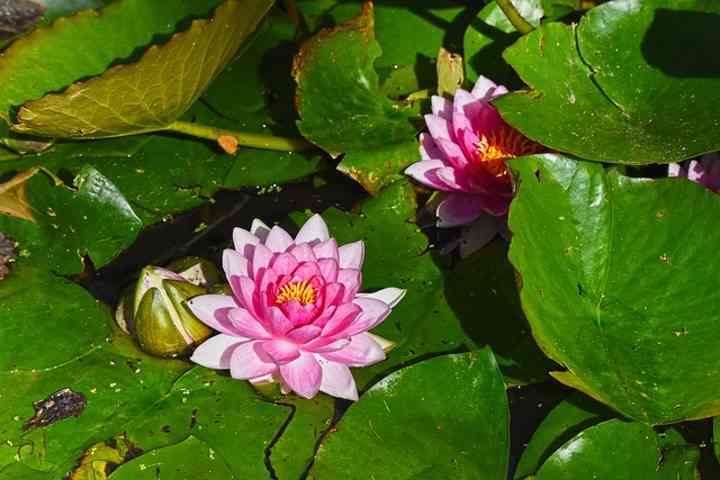
Water lilies are decorative plants with flowers that drift across the water’s surface in a variety of colors. Water lilies are a kind of deep-water plant with long stems that extend from the bottom of ponds to the water’s surface. The surface appears to be covered by water lily leaves, forming a lily pad.
Water lily blooms float on the water’s surface, unlike lotus aquatic blooms. The blooms of these flowering pond plants are the most stunning feature. Orange, white, pink, purple, or yellow blooms may be seen on tall stems. Multicolored and up to 6″ (15 cm) across, some of the most spectacular water lily flowers are found.
Lotus (Nelumbo nucifera) Flowers for Outdoor Ponds

Lotus plants may be pink or white, and they add beauty to any pond. These water plants have long submerged stems that produce leaves and flowers above the pond’s surface. They are planted in the bottom of ponds with soil. The leaves of this kind of plant may be up to 31 inches (78 cm) in diameter. Its long stalks bear white-pink blooms that bloom at the end. Lotus flowers rise above the pond’s surface, unlike water lilies.
The purification of water can be achieved by growing lotus water plants in ponds. They’re great for removing harmful chemicals and metals from freshwater aquatic plants. Full sun is required for growth. Indoors, in an indoor garden pond, you can also enjoy these exotic plants, but make sure it has enough light. Make sure the water is at least 2″ (5 cm) above the soil.
Water Iris (Iris pseudacorus) — Flowering Pond Plants

Water iris is a flowering perennial plant that thrives in temperate climates and is used as an ornamental plant. The plant’s spectacular yellow blooms emerge on the end of long stalks with sword-shaped leaves, adorning the edges of backyard ponds, lakes, and rivers.
These water-dependent marginal plants are partially submerged. Iris grown in full sun or partial shade thrives. Because it thrives in damp, soggy soil that most other plants find difficult, this low-maintenance water plant is ideal for a bog garden.
Water Poppy (Hydrocleys nymphoides)

Water poppies are a popular freshwater plant that may be used to add color, clean water, and provide oxygen to aquariums. These free-floating aquatic plants’ tiny green oval leaves match its delicate yellow-cream blooms in size. Plants may be grown entirely immersed in water as well.
Eventually, on the surface of your pond, their leaves and flowers appear. Full sun is ideal for water poppies. Water plants should ideally grow to a depth of 6 inches (15 cm) below the pond’s surface. Koi or other pond fish may enjoy the floating leaves for shade.
Fanwort (Cabomba caroliniana)

Fanwort is a perennial freshwater rooted aquatic plant with submerged or floating leaves and white flowers. It is an aquatic perennial plant. To oxygenate the water and provide fish with shade, plant fanwort in your backyard fish ponds. Fanwort has a bushy, spiky look when cultivated in water and produces little flowers that emerge on stems above the surface.
American Waterweed (Elodea canadensis)

A flowering water plant with tiny white flowers, American waterweed is a blooming plant. In moderate to bright light, it grows quickly. A common pond plant and aquarium plant is American waterweed. The long stalks and tiny leaves that grow underwater distinguish this plant.
This aquatic vegetation is excellent for improving water oxygen and creating hiding spots for fish. When leaves fall off and root in another part of the pond, they seed, and its green foliage spreads throughout the pond.
Water Purslane (Lythrum portula)
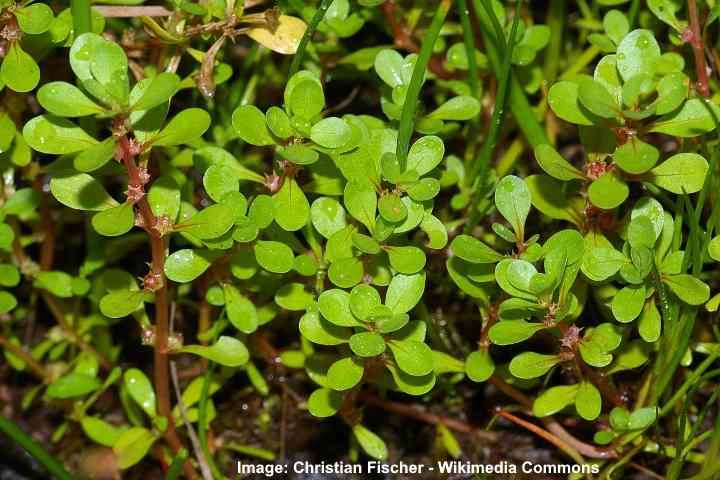
Water purslane thrives in damp conditions and has tiny little slightly fleshy leaves. Depending on the climate, the fast-growing plant can be perennial or annual, and it thrives in partial shade or full sun. A mat of foliage covers the water’s surface with tiny spatula-shaped leaves. Water purslane thrives as a marginal aquatic plant, floating on the water or buried underwater, in marshy regions.
Rough Horsetail (Equisetum Hyemale)
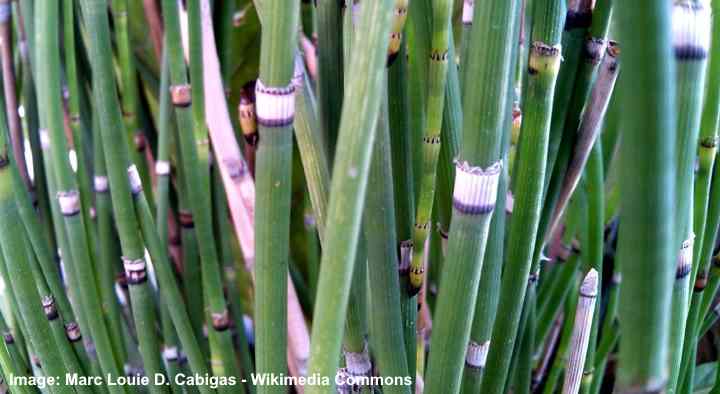
When planted in full to partial sun, rough horsetail has long stems that may spread quickly. Regular pruning is required because the water plant has an aggressive growth habit. Your ponds are given a stunning vertical height of around 3 feet (0.9 meters) by the long thin rush-like stems. Grow in pots before sinking the roots into your pond’s soil to limit expansion.
Umbrella Palm (Cyperus alternifolius)
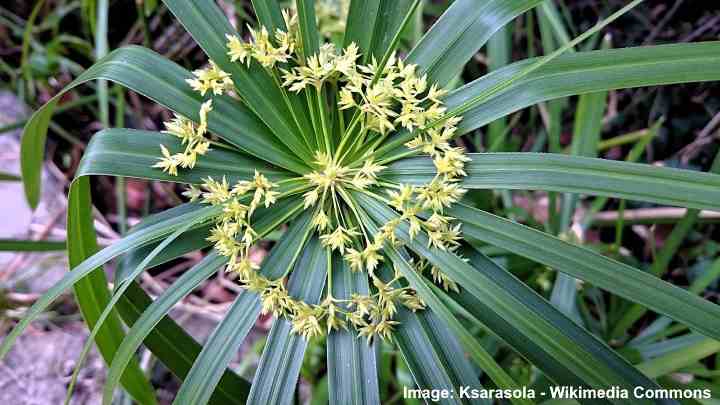
The umbrella palm, sometimes known as umbrella papyrus, is a pond plant with long stems and a palm-like crown that may provide vertical appeal. To add an exotic look to your backyard aquascape, grow this emergent aquatic plant. Umbrella palms provide visual height to your ponds because they grow up to 6 feet (2 meters) tall. Planting in containers to regulate the fast development of umbrella palms in ponds.
Mosaic Flower (Ludwigia Sedoides)

From June to August, the mosaic flower blooms as a floating pond plant. On the water’s surface, its diamond-shaped reddish-green leaves create an elegant design. This perennial water plant has lovely yellow blooms in the summer when it is growing in full sun. For shade and protection, grow floating leaf-plants in fish ponds.
Cattail (Typha)

About 30 species of cattail grow in marshy environments, and they are among the most beautiful marginal water plants. Bulrush, reedmace, and reed are other popular names for this popular emergent plant. Around lakes and ponds, these watery or semi-aquatic plants flourish. The long, slender reeds may reach 2 to 6 feet (0.6 to 2 meters) in height, depending on the species. The enormous sausage-like development on the ends of the reeds is a distinguishing characteristic of cattail.
Water Hawthorn (Aponogeton distachyos)
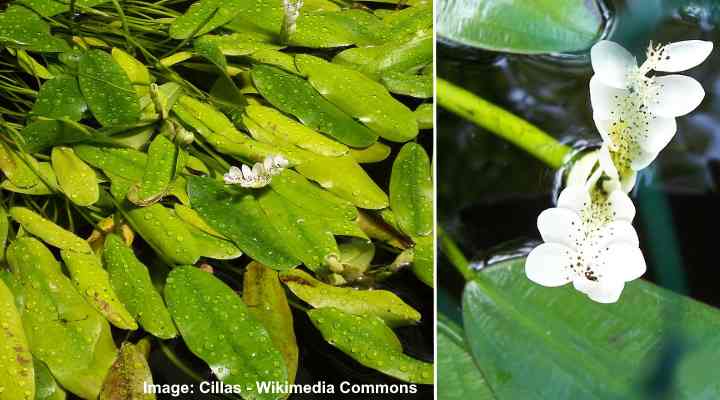
Water hawthorn is a lovely aquatic flowering plant with fragrant white blooms. Its big lanceolate leaves dangle in the water, obscuring a layer of greenery over the water. At the end of upright stalks, dainty blooms appear. Water hawthorn plants have a similar growth habit to water lilies.
These are ideal for ponds with a depth of up to 3 feet (1 meter). When grown in full sun, the gorgeous white blooms produce a pleasant fragrance.
Flowering Water Plants – Beautiful Aquatic Flowers
Beautiful aromas and colors can be found in a garden pond with growing flowering aquatic plants. Large, spectacular blooms characterize some of the best water plants. Pond plants may spread out across a pond’s surface when they flourish and reproduce. The best aquatic blooming plants are listed below:
- Water iris. The flowers are typically brilliant, sunny yellow in hue and these emergent aquatic flowering plants.
- Lotus plants. These floating or towering water plants feature exotic blooms that may grow to be tall. Up to 8″ (20 cm) in diameter, some of the most stunning lotus water flowers are available.
- Water lily plants. Water lilies are one of the most spectacular aquatic flowers, with 60 species in total. They have star-shaped blooms that are fairly fragrant. The huge floating leaves contrast with the smaller blooms of pink, yellow, purple, white, orange, and red.
- Water hawthorn plants. Long upright blooming stems extend out of the pond’s surface, adorned with these flowering water plants. A sweet fragrance reminiscent of hawthorn is released by the tiny white blooms.
- Mosaic flower. floating aquatic pond plants are stunning
- Flowering water poppies
